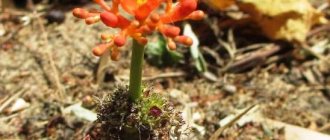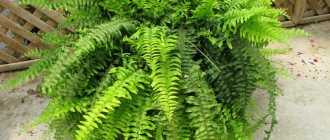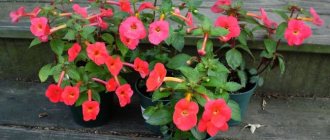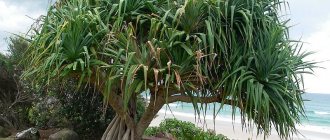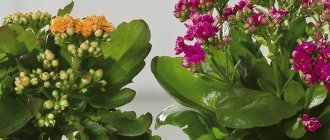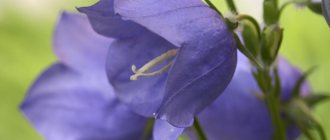Mint is an amazing plant in every sense. The most important advantage of the spicy plant: it can be used for the benefit of your health, or rather, to make healthy tea that calms the nervous system, refreshes, and helps you sleep if you have insomnia. At the same time, the mint drink is very tasty, and the appearance of the plant is interesting and cute! For those who want to be able to cut a fresh herb all year round, there is a solution: growing mint on the windowsill. Below we will talk about all the rules and features of planting and caring for mint in apartment conditions.
Pot and soil
The size of the pot depends on how much mint you want to grow. The minimum size is 15 cm, the average is 30-35 cm. The pot should not be deep, because the mint roots are located very close to the surface. Make sure there are drainage holes at the bottom.
For successful growth and development of mint, you need loose, fertile, well-drained soil. The soil for growing mint at home should have a slightly acidic pH between 6.5 and 7.0.
To limit the plant's rapid growth, ensure that mint stems do not fall or touch the ground, as they take root very quickly.
Growing mint by root layering
The long, spreading roots of mint have dormant buds. Therefore, the plant can be propagated through root layering. Below are the instructions:
- At the end of summer, root cuttings up to 12 cm long, having 2-3 buds, are taken.
- They are immersed in moist soil to a depth of 5-6 cm.
- If the buds on the root have already awakened and sent out shoots, then the above-ground parts after planting are cut off approximately 5 cm from the top.
- The buds wake up and sprout on average 2 weeks after planting.
Varieties for cultivation
There are endless varieties of mint, each with its own special aroma - lemon, pineapple, grapefruit. Some people grow several different varieties in one pot at once, it looks very impressive.
For growing on a windowsill, peppermint varieties with a classic smell are most often chosen:
| "Krasnodarskaya" | |
| "Strawberry" | |
| "Fun" | |
| "Medicinal" | |
| "Moldavian" |
What is required for landing
The root system of mint develops in breadth, so it is recommended for planting to choose shallow containers, small pots, flowerpots and balcony boxes with a diameter of 20 cm or more. Holes should be made at the bottom to drain excess liquid.
The plant is not demanding on soil, but for good growth performance it is advisable to provide it with nutritious, loose soil. You can choose one of the options:
- a mixture of peat and fine sand;
- humus and garden soil in proportions 1:2;
- universal primer mixed with sand.
Garden soil must be disinfected before use, for example, by spilling it with a weak solution of potassium permanganate. At the bottom of the container, regardless of the composition of the soil mixture, always place drainage (small pebbles, expanded clay), which prevents stagnation of liquid and rotting of the roots.
How to grow mint at home on a windowsill
There are three ways to propagate mint: seeds, cuttings and root division. To grow it in an apartment, the first two are suitable.
From seeds
The best time to sow mint is March-April.
How to plant mint from seeds:
- Fill a flat wide container with soil.
- Seeds are sown on the surface of the soil.
- Sprinkle with a thin layer of soil substrate.
- Water with water from a spray bottle.
- Cover the pot with film.
Mint seeds should germinate within 10-15 days (sometimes longer) at room temperature or slightly warmer. Once germinated, the tiny seedlings will be fragile, so be careful when watering. In the phase of two or three true leaves, they are picked into separate pots.
The method of growing mint from seeds takes quite a long time and requires much more attention and care compared to cuttings or dividing roots.
From a cutting (twig)
The best way to quickly grow mint in an apartment is to take cuttings from the varieties that you like best.
- Take mint cuttings (sprigs) about 12-15 cm long from an adult plant and remove the lower leaves.
- Place the stems in a glass filled with water and place on a well-lit windowsill. The mint roots will take several weeks to develop. Be sure to change the water when it starts to get cloudy to keep your plant healthy.
Once the roots have grown, plant the mint in a pot of soil:
- Fill the pot with fertile soil, leaving 2 to 3 cm at the top.
- Make a hole in the ground in the center of the pot so that part of the stem with roots fits there.
- Place the branch in the hole, cover the roots with soil and gently tamp it around.
- Gently pour water at room temperature.
Life hack “How to grow mint at home in a few days” – video
How to feed mint
If the seeds were sown in fertile soil, you can do without fertilizing when growing mint. But still, most gardeners fertilize the soil once a year (at the beginning of summer) with the most harmless nitrogen fertilizer - urea (urea). The concentration of the solution is 1 g/l. And in very advanced cases, you can use a diluted solution of complex mineral fertilizer, for example, azophosphate. The soil around the plants is watered with a fertilizer solution. In winter, fertilizing is not needed. You should be very careful when using fertilizers: excessive amounts of them negatively affect the taste of mint leaves and reduce the aroma.
Caring for mint at home
Mint has very few needs other than watering and fertile soil. To be honest, this plant is quite difficult to kill. Here are a few conditions necessary for the normal growth and development of mint.
Lighting
Mint can tolerate shade, but it needs a minimum of 3-4 hours of sunlight per day to grow well.
Temperature
This spicy plant loves moderate temperatures: indoors it should be at least 18-21 C during the day and 13-15 C at night.
How to water
Mint prefers moist soil, but don't overwater it. If the top of the soil becomes dry to the touch, only then is watering necessary.
Spray the plant with a spray bottle between waterings or place the pot on a tray filled with water with pebbles.
Top dressing
Spices grown at home do not need to be heavily fertilized, otherwise they will lose their taste. To feed mint, use liquid all-purpose fertilizer when you notice that the plant is weak.
Trimming
Regularly prune long mint branches to encourage more bushy green growth and to maintain the plant's beautiful shape.
Don't let the flowers bloom and pinch them back as soon as you notice them. Flowering dramatically reduces the quality of greenery.
Pests and diseases
Being very aromatic, mint almost never suffers from pests and rarely falls victim to disease.
Mint sometimes develops small orange spots on the undersides of its leaves. In this case, use organic fungicides (products to combat fungal plant diseases) and let the soil dry out between waterings.
In rare cases, mint can be attacked by spider mites, aphids, and powdery mildew.
Planting mint from cuttings
For cuttings, it is optimal to use mint cuttings with a renewal bud and at least five leaves. First you need to put the cuttings in water for germination. The roots will appear in about a week, and it is better to plant them in the ground three days after they appear.
To begin with, you can plant the cuttings for rooting in individual cups. And then, if they take root safely and begin to grow, they can be transplanted into a larger container. However, you can immediately plant the cuttings in a wide pot or container. The optimal distance between them is 10-15 centimeters.
To plant the cutting, make a hole in the container. Immerse the cutting in it so that the entire part with the roots is in the hole, while the roots should be evenly positioned and not bent. Cover the cuttings with soil, gently compact the soil around with your fingers and water generously with clean water.
The first time after rooting, you need to water the plants regularly. The soil must be regularly moist. Also, the first two after planting, it is recommended to shade the mint from direct rays of the sun.
Harvesting
You can start harvesting mint leaves once the plant has a few stems about 15-18 cm long. This will take about 2 months if you grow it from seeds, and a few weeks less if you planted sprigs.
The best way to harvest mint is to cut the greens as you need them. Never prune more than one-third of the plant, otherwise it will cause growth to be temporarily stunted.
Now, having received detailed recommendations for growing mint on the windowsill, you can enjoy freshly picked fragrant leaves all year round, even in winter!
When can you harvest mint from the windowsill?
If you sow mint with seeds, the first shoots appear, as a rule, after 2-3 weeks. You can pick the leaves for making tea or any dishes approximately 3-3.5 months after sowing the seeds. When planting cuttings or rhizomes, you can harvest mint much earlier.
Advice! If you want to get more aromatic, spicy and fragrant leaves, it is recommended to harvest mint when the flower stalks form. It is at this time that the leaves contain a large amount of essential oils.
Subsequently, after harvesting, you can periodically tear off the leaves. New leaves and shoots will gradually grow. This way, you can have access to fresh, tasty and healthy mint all year round!
Mint grows quickly in a pot, so after some time it will need to be transplanted into a new, larger container. Or you can divide the root ball into several parts, plant them in different containers, or transplant some into open ground in the country.
Description of indoor mint
Indoor mint (Plectranthus aromaticum) or spur flower is a perennial evergreen herbaceous plant of the Lamiaceae family with oblong, oval, pointed leaves. The flowers are small, pale, collected on the upper shoots in umbrellas or racemes, appearing in summer. The root system is fibrous, the stem is ribbed, smooth or pubescent. The plant is hanging, but some species are classified as shrubs with shoots up to 40 cm and abundant foliage.
If you run your hand over the leaves, a pleasant smell will immediately spread.
Features of Plectranthus
Home plectranthus, also called indoor mint, is a herbaceous perennial or evergreen shrub, reaching a height of 0.6 to 0.8 m. The root system is fibrous, and the branched stems can grow vertically or be creeping. The rich green or brownish-red ribbed stem has slight pubescence.
Diseases and pests
Young mint sprouts, like the mother bush, are a tasty morsel for diseases and parasites. The mint flea flea attacks most often. It spoils both the root system and the above-ground part. To combat it, it is treated with chemical insecticides (Karbofos).
Important! The leaf beetle also likes to settle on foliage. It often attacks bushes with increased dampness and excessive watering. To combat it, it is necessary to eliminate favorable conditions for the pest to live - more ventilation and reduced watering.
In addition, the plant can be affected by diseases - rust and powdery mildew. To combat rust, the bush is ruthlessly removed from the collection so that the disease does not have time to spread to other specimens. And in the case of powdery mildew, it is sprayed with colloidal sulfur.
To prevent the appearance of parasites and diseases, you need to constantly monitor its conditions. If you notice the appearance of pests in the first stages of infestation, there is a chance of getting rid of them without significant losses.
Possible problems
Often, due to improper care, mint becomes covered with dark rusty spots, the appearance of which can be caused by excessive soil and air moisture, lack of heat, drafts, or excess nitrogen in the soil. Damaged parts of the plant are cut off, the remaining parts are sprayed with fungicides. Before use, processed greens are soaked for at least half an hour in cold water.
Transplanting a plant from a garden plot into a pot without first washing the roots can provoke infection with various diseases. One of the common ones is powdery growth, which covers the leaves with a whitish coating. Spraying with a 1% solution of colloidal sulfur allows you to get rid of a fungal infection.
For your information! It is not uncommon to see brownish-brown spots on the leaves, companions of anthracnose and septoria, which can be eliminated by treating them four times with 1% Bordeaux mixture.
Planting in untreated soil can provoke attack by small insect pests such as mint flea beetles, scale insects, mint mites and leaf beetles, leaving behind gnawed leaves in several places.
You can brew refreshing, tonic tea and prepare aromatic desserts with fresh mint leaves all year round by growing mint at home in a pot on the windowsill. The main thing is to provide it with regular moderate watering and sufficient heat and light.
Your personal gardening consultant!
On a summer evening, sitting comfortably on a sun lounger, it’s nice to drink a cup of tea flavored with green leaves of fragrant mint.
Such pastime is not only pleasant, but also useful in terms of maintaining your health at the proper level. Although, why are we talking about summer? After all, you can enjoy this noble drink anywhere, at any time of the year, whenever you wish. And for this you only need one thing - to have fresh mint at your disposal all year round. The statement is interesting, but where can you find mint leaves in winter, on snowy ground? But you won’t have to look for anything if the fragrant plant grows in a pot on the windowsill. And in order for it to grow, you just need to be a little oriented in the question of how to grow mint at home in the winter. And why not? If mint grows in “wild” conditions, it will grow even more so in greenhouse conditions. Properly selecting all the necessary components, observing the conditions responsible for its proper growth - these are all the requirements for home cultivation. Now everything has been said in detail and step by step.
What is mint grown from?
There are two ways to grow mint indoors. The first method is from seeds. Simple in essence, but requiring some knowledge of “mint” varieties. Since the seeds will be purchased, you should initially know what to buy. Without knowing the grade, it is difficult to get what you want.
The second method is growing from cuttings. On the one hand, the option is troublesome, planting material needs to be prepared, but on the other hand, we will get mint faster, because nothing is germinated, but only grown, and the variety will be the one we want. We take cuttings from a plant that we see and have tasted.
How to plant seeds
Let's look at how to grow mint on a windowsill from the most convenient planting material - from seeds. The procedure is simple. Purchased or personally collected seeds are taken and placed in holes or grooves. To make it less work, and it will be more convenient, the seeds can be gently pressed into the soil, instead of spreading them out and then covering them with an additional layer. Planting depth 0.5 centimeters. For full germination of planting material on the windowsill, no special conditions are required. A normal room temperature of 20-25ºC and moist soil is sufficient.
The next method on how to grow mint at home quickly and efficiently is cuttings and roots. You will be able to indulge in fragrant tea in just two to three weeks. But first, prepare the material. To grow mint at home on the windowsill, you can choose either upper or lower cuttings. In the first case, the top of the plant is cut off by 8-10 centimeters. In the second case, part of the rhizome is taken for “seedlings”. Or the entire root, if it is small. Cuttings from the top of mint are pre-germinated in containers with water or wet sand. After young roots appear, they are transferred to a separate container (pot, box) for further growth. Cuttings from the root system are planted directly into prepared, well-moistened soil. Everything else is the same as with seeds, but covering the “bed” is not necessary.
Soil and containers are the right choice
To plant mint seeds, it is recommended to take one large box, the size of a windowsill. First, all planting material is planted in one container. After the first greenery appears, each plant is transplanted into an individual pot. But if desired or necessary, everything can be left as is, removing the weakest plants from the general growth and planting healthy ones from one another at a distance of 5 centimeters. For cuttings, pots are used immediately. Plant replanting is not expected here.
On the ground. Mint loves fertile, loose soil. To grow mint at home on a windowsill in winter, you can use ordinary garden soil, well-fertilized. It would be nice if it had some sand in it. A good option is peat soil. Mint also produces an excellent harvest there. In the case when there is neither one nor the other, garden soil is taken (2 parts) and mixed with humus (1 part). And the last thing is the purchased substrate. Ideal option for city dwellers.
When filling containers with prepared substrate, do not forget to create a drainage layer at the bottom of the pots or box. A layer of two to three centimeters of expanded clay or small crushed stone will be enough to remove excess water from the soil.
Providing optimal conditions for growing mint on the window
Lighting
The place where the pot with the planted seeds or cuttings will stand should be light, but without direct sunlight. Partial shade would also be nice.
Depends on the illumination of the “vegetable garden”. 20-25ºC heat without drafts is just the norm if the pots or boxes are in a well-lit place. When there is not enough daylight, it is recommended to reduce the room temperature to 15ºC or place young greenery on a less heated balcony. In low light and high temperatures, the mint stems will be thin and the leaves will be defective.
Since mint can be grown at home at different times of the year, watering the plant should also vary in intensity. In winter, the beds are watered moderately, avoiding excess water and the formation of dirt. In summer, the regularity of watering is slightly increased due to the increased ambient temperature. But even relatively increased watering should not lead to the plant’s root system being waterlogged.
Winter feeding of mint is not required. Perhaps, feed the cuttings at the beginning of their vegetative period (when the first young shoots appear). For feeding, it is recommended to use a solution: 1 gram of urea per 1 liter of water. In the summer, it is allowed to apply mineral fertilizers, but in a gentle quantity that is safe for health and only at the stage of the appearance of the first leaves.
Planted, germinated, grown, harvested - easily, quickly, pleasantly. Mint is probably the only plant that gardeners truly enjoy growing and caring for at home. Its beautiful appearance and pleasant aroma in the room, in addition to its beneficial qualities that help prevent a wide variety of diseases, make mint indispensable when there is a shortage of truly fresh, fragrant herbs.
Share useful information:
Green mint all year round on your windowsill
It would seem, why add extra trouble to yourself and grow mint at home, if you can make the necessary supply in the summer by drying aromatic herbs for future use. However, dried mint does not have such a bright taste and rich aroma as a fresh plant, and some of the beneficial properties of mint are lost during processing, which is also quite important. No essential oil can compare in its properties to a living plant. In addition, growing mint on the windowsill does not require much effort - it is enough to take simple care of the plant and there will always be fresh herbs on the windowsill! There are two possible ways to grow mint both in the country and at home. The first option is to grow healthy greens from seeds, the second using cuttings. But keep in mind that mint sprouted from seeds immediately after the sprouts appear produces very tender, incomparable greens, while mint from cuttings is immediately “adult”, that is, somewhat hard and rough. However, “cutting” mint has a more pronounced taste, but “seed” mint has a more pronounced aroma.
Growing mint at home is not only useful, but also beautiful.
Whichever of the two methods you choose, first of all you need to prepare the seats.
As for containers, it all depends on your own preferences and capabilities, since mint can be grown, including in flower pots, especially since a green mint bush will look like a decorative house plant, so growing mint at home is not only useful, but also beautiful. But we do not recommend taking a container that is too small, since the plant has an extensive and strong root system, and if there is not enough space, the greens will be frail and not powerful enough.
Video about how to grow mint at home
As for the soil, it is better to take care of this issue in advance. Since mint grows best in acidified soil, you can prepare a soil mixture based on peat. If there is no time to prepare the soil, then you can purchase a ready-made substrate in a store, or dig up soil at your dacha. In the latter case, when digging in the garden, it is worth taking richer and more fertile soil. In addition, if the soil was taken from the garden, it cannot be used without light disinfection to destroy pathogenic microbes. The easiest way to do this is to spill the prepared soil with a weak solution of potassium permanganate and then calcine it.
Further actions depend on which method of planting mint (cuttings or seeds) you chose.
Necessary conditions for growth
Humidity and temperature
Mint loves moist air. It grows well at humidity levels around 80%. In the heat and heating season, it is recommended to spray the green mass with settled water.
The optimal temperature for the rapid development of greenery is considered to be from +22°C to +25°C. At lower temperatures, the growth rate of the plant slows down.
In summer, mint is grown on the balcony, and for winter, a windowsill with good lighting is perfect. If the plant is bushy and tall, you can place the pots on the floor or shelf.
Lighting
Mint needs to be provided with diffused light, since direct sunlight can cause burns on young stems and leaves. A good option would be to install a container with greenery on the windowsills of windows facing east or west.
If the windows face south and there is no other option for planting, then at midday it is recommended to cover the greenery with a paper barrier or put the pots in the shade.
From late autumn to the beginning of the spring season, plants usually suffer from lack of light. Signs of malaise include stretching of leaves, a decrease in green mass, and the acquisition of a pale color. In such a situation, it is important to create an additional supply of scattered ultraviolet radiation.
In winter, the plant goes into hibernation and grows slowly. During this period, plantings are provided with protection from drafts and cold. With the onset of the warm season, the growth process will be activated, and to speed it up, the upper leaves are cut off. This will stimulate the appearance of side shoots.
Beneficial and harmful properties of mint
My friends, mint is a spicy and aromatic plant known for over a hundred years for its healing properties. I’ll tell you what information I found about the benefits and harms of mint.
Benefit
- Tannins from the plant have an anti-inflammatory and antibacterial effect.
- Vitamin D improves skin condition.
- B vitamins normalize the nervous system.
- Magnesium and vitamin A strengthen blood vessels and the heart.
- Carotene is good for vision.
- Essential oils relieve pain and spasms.
- Organic acids and betanin improve the functioning of the gastrointestinal tract.
- Phytosterols help break down cholesterol plaques.
- The complex of minerals increases the tone of the body.
- Decoctions are used to prevent fungal diseases and treat acne.
- In cosmetology, mint works as a flavoring and tonic component; masks smooth out fine wrinkles.
Harm
Plants that contain essential oils and menthol have a number of contraindications.
- Give with caution to children under 3 years of age, with the exception of external use.
- Pregnant women should not drink mint infusions, because they cause contraction of the uterine muscles and can cause a miscarriage.
- It is also better for nursing mothers not to drink mint infusions; they reduce the formation of milk.
- People prone to allergies should avoid consuming the spice.
- People with acute liver and kidney diseases, varicose veins and low blood pressure are not recommended to use tonic mint drinks.
Author's note
Natalia Papanova
Blog author
Use all medicinal herbs after consulting a doctor and do not drink excessively.
Watering
Mint on the windowsill prefers regularly moist soil, which should not be overdried or watered.
How to water indoor spices
Watering rules:
- In the warm season, the plant is watered with a small amount of water every 2-3 days after the top layer of soil has completely dried. Excess moisture flows into a pan, from which it must be drained to prevent the development of putrefactive processes in the roots.
- During the heating season, the frequency of watering is reduced to once every 7 days when the air temperature is within normal limits (17-23 °C).
- Regular spraying is recommended to clean the foliage of dust particles.
- Water for irrigation and spraying should be left standing for 3-4 days, at room temperature.

